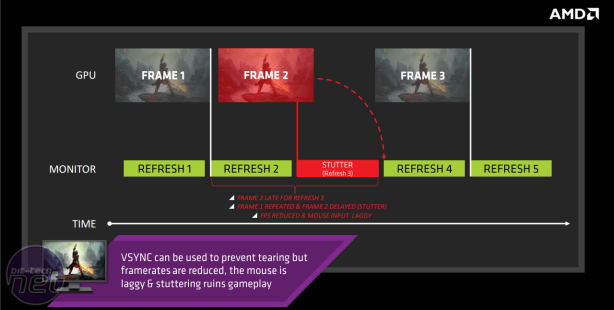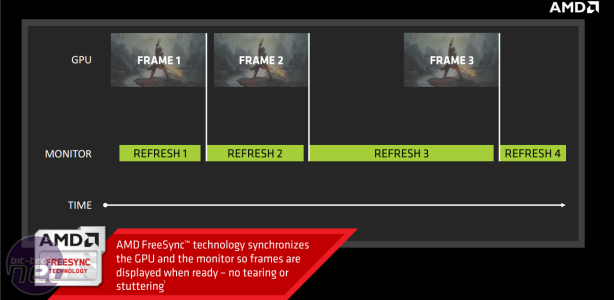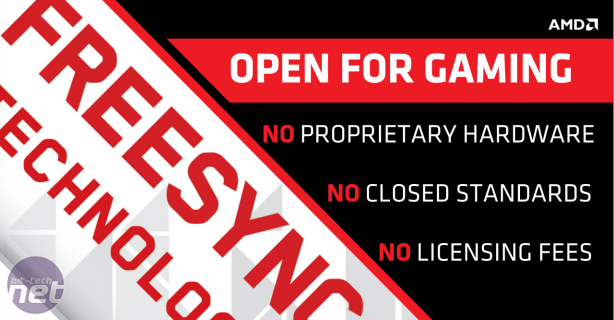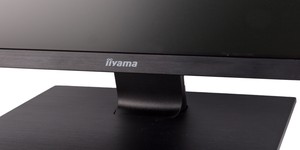
AMD FreeSync Officially Launches
It's been a long time coming, but AMD's FreeSync gets its official launch today. Monitors that support the technology have already begun shipping, but today is the release of the first AMD driver that supports FreeSync on compatible hardware, with a further update penned for April for CrossFire users. With the embargo lifted, reviews of the aforementioned panels will also be appearing now; we sadly don't have a review sample ourselves, but we thought a rundown of FreeSync would be useful since it's not something we've delved into in much detail before.Why FreeSync?
Firstly, a quick refresher on why FreeSync exists. Most PC gamers are familiar with screen tearing, a graphics artifact that results from the typically asynchronous relationship between a GPU's frame rate in a given game, which varies constantly, and a monitor's refresh rate, which is fixed. For example, most screens have a refresh rate of 60Hz, and thus update the image 60 times a second, or every 16.67ms. However, a game is rendered as fast as possible by the GPU, sending frames to the screen as soon as they're rendered – almost always at an inconsistent rate as the workload constantly gets easier or harder for the GPU to process. If a frame is delivered during a refresh, the monitor will draw part of the previous frame and part of the newer one, causing horizontal tears in the image.V-sync (vertical synchronisation) is very effective at eliminating this effect by forcing the GPU to deliver frames at a rate consistent with the monitor's refresh rate. If you're rendering frames constantly at or above your monitor's refresh rate, this generally works ok, though it can introduce the occassional feeling of input lag. However, your render rate dips below the refresh rate even slightly, the display is forced to repeat the previous frame, which introduces stutter and more input lag.
Panels with variable refresh rates aim to solve both problems, which is where FreeSync comes in. It means a monitor can change its refresh rate to match the GPU's render rate, making the display a slave to the rendering hardware rather than the other way round. Ideally, this will eliminate both tearing (since you're never updating mid-frame) and stutter/lag (since you display a frame as soon as it's rendered and never repeat them).
FreeSync vs. G-Sync
As many of you will know, Nvidia beat AMD to the punch for variable refresh rates with its G-Sync technology, both as a demo and as a final product. G-Sync relies on a custom-made scaler which replaces that used by a monitor, and was even initially sold as a manual upgrade kit for specific panels already available. However, both G-Sync and FreeSync use the same method to achieve variable refresh rate – manipulating a panel's VBLANK period, the time between the end of the previous frame's render process and the start of the next.While it has arrived later, FreeSync takes a different approach to G-Sync's custom hardware, leveraging instead a relatively new industry standard known as DisplayPort Adaptive-Sync, which became an optional part of the DisplayPort 1.2a specification in May last year. Variable refresh rate has been around for some time, having previously been included in the embedded DisplayPort (eDP) specification, where it has benefits for power draw (e.g. reducing the refresh rate when displaying static desktop content). As well as games, it can also be beneficial with video playback, matching a panel's refresh rate to that of the content being played to avoid stuttering and/or the need for post processing which aims to reduce that.
The reliance on an open set of industry-wide standards instead of custom hardware is partly where the name FreeSync is derived. While it still requires the latest generation of hardware, this hardware is not controlled, produced or licensed by AMD; in fact, there's nothing technically stopping Nvidia from implementing DisplayPort Adaptive-Sync in its own GeForce products.
According to AMD, this made it an easy sell to monitor and scaler vendors, and this is certainly easy to believe. In September, the company struck a deal with three major scaler manufacturers (Realtek, Novatek and Mstar) to have FreeSync capabilities incorporated into future scalers. Since these manufacturers don't have to pay a license fee to AMD or VESA to do this, there should be minimal extra cost for monitor vendors looking to implement these newer scalers. Said vendors also do not have to fork out for a proprietary piece of hardware over which they have little control.
This all makes it cheaper to implement, with AMD saying these savings will be passed onto the users. It also means display manufacturers can retain certain features that they cannot with G-Sync, such as additional inputs, audio over DisplayPort and custom OSDs with additional colour and image processing capabilities. Essentially, AMD is saying that FreeSync support can be added with relative ease and minimal cost to existing and new products without reducing functionality, whereas G-Sync requires significantly different and more expensive hardware and ultimately the development of new specific G-Sync products distinct from existing solutions.

MSI MPG Velox 100R Chassis Review
October 14 2021 | 15:04











Want to comment? Please log in.